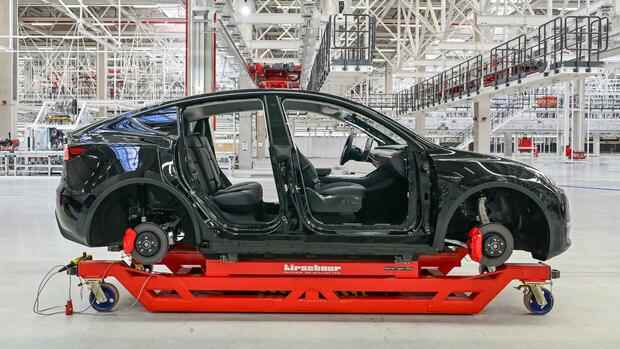Berlin Two years ago, Elon Musk received incredulous murmurs with his surprising announcement that Tesla would build a factory on the outskirts of Berlin. Now the project is about to be completed and the hype has never been greater.
The large number of innovations that Musk wants to implement in the plant for the first time are Henry Ford’s revolutionary assembly line, the analysts recently cheered. VW CEO Herbert Diess is alarmed: Tesla will be able to assemble an electric car in a third of the time that his house needs – a discrepancy that could cost its own workforce dearly.
Musk himself calls the innovations that Tesla is working on, without false modesty, a revolution in body construction. Gigantic machines are to be used, long as semi-trailers and high as two-story houses, to press front and rear body parts from a single piece of metal. This saves time and money, reduces weight and increases the range.
Anyone who followed the market launch of the Tesla Model 3 a few years ago already knows the hustle and bustle. Even then advertised Musk trying to build a highly automated manufacturing system that he compared to alien battleships. The attempt went catastrophically wrong and Tesla almost broke. Today, however, the company has very different resources at its disposal to implement its vision of new ways in automobile manufacturing.
Top jobs of the day
Find the best jobs now and
be notified by email.
“Tesla has the ability to completely reinvent the processes of vehicle production and the factory,” wrote Adam Jonas, Morgan Stanley’s top auto analyst, in his monthly report. “Tesla is building the car factory of the future.”
“Daimler and BMW would never do that”
Musk explained the differences in production in a tweet in January: “With our huge casting machines, we’re trying to make full-size cars just like building toy cars.”
The electrical pioneer describes the process on posters at the Grünheide plant, which Tesla showed to the public on the open day in October. Aluminum is injected into the largest die-casting machines in the world, which then form the metal with 6,100 tons of pressure – the weight of around 4,000 cars.
The plant is to house eight of these machine monsters. Musk wants to use it to produce the two largest parts of the SUV Model Y – the front and rear underbody – from just one piece of metal. Today the rear underbody of the current Model 3 consists of 70 metal parts.
The Gigafactory in Grünheide should build a car in just ten hours.
(Photo: dpa)
Musk calls the machines “giga presses”. This suggests that Tesla makes them itself, but they actually come from the manufacturer Idra in Brescia in northern Italy, who has so far sold them to three customers on three continents. It is said that they are in talks with other car manufacturers and major suppliers.
The front and rear castings are connected with frames through which the batteries are integrated directly into the chassis. This also reduces the complexity: Tesla and other manufacturers previously put their batteries in metal sheets, which are then sealed with separate base plates.
Musk last presented the advantages of simpler and better integrated battery and body production at Tesla’s “Battery Day” last year and announced massive improvements in investment requirements and the production space required.
“Tesla is radically questioning the existing structures and manufacturing processes,” says Albert Waas, automotive partner at the Boston Consulting Group. “Daimler and BMW would never do that.”
Grünheide becomes a pioneer
Despite all the advantages that Musk holds out in prospect, he also admits that things could go wrong in Grünheide, an hour’s drive east of Berlin. “Many new technologies are being developed in Berlin, which brings with it a considerable production risk,” tweeted Musk in October last year. The Tesla plants in Shanghai and Fremont, California, should adopt the new technologies in about two years, if they prove themselves.
Five months after this tweet there was a minor fire in the “Giga-Presse” in Fremont. The machine melts aluminum alloys at up to 850 degrees Celsius before the metal moves into a slightly less hot holding furnace. According to Morgan Stanley’s auto specialist Jonas, this manufacturing process is so complicated, among other things, because the liquid metal has to be distributed at a speed that ensures even cooling of the entire component.
German automakers are watching Tesla’s progress with eagle eyes. VW is considering building a brand new electric car factory near Wolfsburg for 250,000 vehicles per year as a direct response to Musk’s initiative. At the beginning of the month, CEO Diess urged his employees that Tesla could produce an electric car in just 10 hours, while VW in Zwickau would need over 30 hours to do so. VW’s new factory must be just as fast.
Tesla could build more than eight million cars by 2030
Tesla currently states its Fremont capacity is 500,000 vehicles per year. Jonas from Morgan Stanley now estimates that the company will be able to build an average of more than 800,000 vehicles per plant by 2030. In total, that would be 8.2 million pieces – compared to a capacity of 1.3 million today.
The moment that will change the production of electric cars in the way that Henry Ford’s assembly line did is yet to come, said Jonas, referring to Ford’s breakthrough in 1913. “We believe this moment is approaching. And we believe Tesla is uniquely positioned to push the boundaries of automotive manufacturing. “
Milan Nedeljkovic, Head of Production at BMW, recently said that his house has not yet worked with large cast components like Tesla. That would be at the expense of flexibility if you want to build several different models on the same assembly line. Nonetheless, Tesla’s approach is exciting. “If it works, we might consider it,” says the manager.
More: “Trinity” project: VW is planning a completely new plant for electric cars in Wolfsburg
